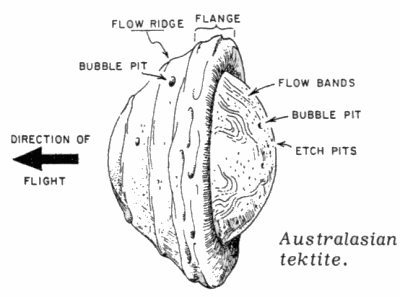 |
Science Frontiers ONLINE No. 136: JUL-AUG 2001 |
|
|
The Stealth Catastrophe
The present consensus holds that the Australasian tektites originated when a large celestial body slammed into our planet somewhere in Southeast Asia. The energy of the impact splashed droplets of molten rock into the atmosphere, where they were shaped aerodynamically and then fell as tektites. The extent of the immense Australasian-tektite strewn field implies a hard-to-miss crater about 100 kilometers in diameter. Yet, despite the geological recency of the event and despite much geological surveying, no convincing crater has been discovered. (SF#115) So, we have abundant evidence of a terrestrial event encompassing much of the planet but no "smoking crater"!
The mystery deepens when one realizes that whatever cataclysm sent the Australian tektites aloft may have been comparable in magnitude to the impact that extinguished the dinosaurs (and other fauna) some 65 million years ago. This much older event has its craterburied below the Yucatan and is further marked by widespread biological extinctions. In contrast, the Australasian-tektite event is not only minus an obvious crater but seems to have had scant effect on the earth's cargo of sensitive life forms. It was a strangely "gentle" event despite the rocky deluge of tektites. What really happened?
(Paine, Michael; "Source of the Australasian Tektites," Meteorite, p. 24, February 2001. Varricchio, Louis; "Tektite Origins," Meteorite, p. 4, May 2001.)
Comment. Was the Australasian-tektite event an encounter with mirror matter, perhaps like Tunguska might have been?
We would be derelict not to mention here the claim by J.A. O'Keefe and others that the rain of Australasian tektites originated in an impact event that occurred not on the earth but rather on the moon. A lunar impact would obviously not require a terrestrial crater, and earthly biota would be spared. The debate over the possible lunar origin of this tektite fall has been particularly bitter. Those interested should refer to: O'Keefe, John A.; "The Coming Revolution in Planetology," Eos, 66:89, 1985.
 Australasian tektite |
Other Sites of Interest
|